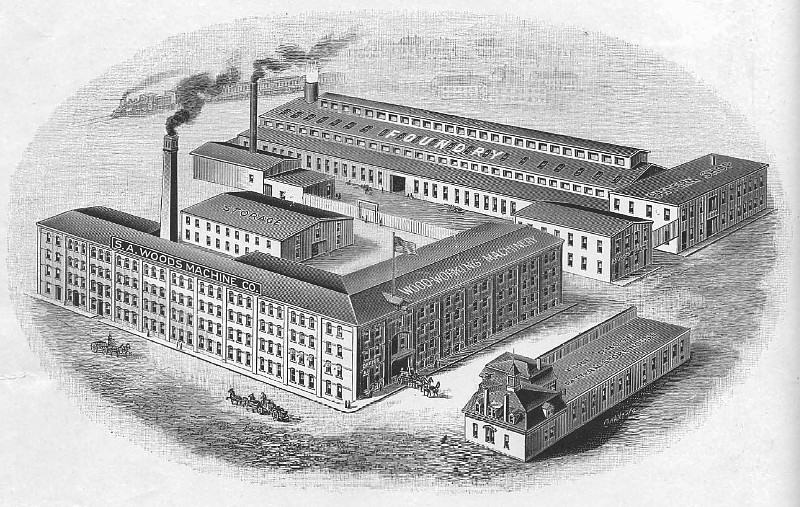S. A. Woods Machine Co. was one of the big, early manufacturers of industrial woodworking machinery. The March 1956 issue of The Wood-Worker carried a history of S. A. Woods Machine Co. that we have made available.
 |
| 1898 Factory View |
In about 1920 the company acquired Boston-based H. C. Dodge, Inc., makers of metalworking lathes and AC induction motors. So far as we know, S. A. Woods discontinued the lathes but they manufactured high-quality electric motors for many years. And Harry C. Dodge became president of S. A. Woods at some point, a role he occupied for 30 years except for a break during the war as explained below.
The May, 1919 issue of The Wood-Worker says the following:
"Among the first settlers at Farmington, Me., were the ancestors of Solomon Adams Woods. He was active on his father's farm and in winter attended the district school, later graduating at the Farmington academy. He was fond of study and gained a remarkable education. He learned the carpenter's trade when twenty years old, moving to Boston four years later.
"Within a year of entering business with Solomon S. Gray, he bought out his employer, and in 1852 began the manufacture of sash, doors and blinds. Two years later he formed a partnership with Mr. Gray, under the firm name of Gray and Woods. In the meantime, Mr. Gray invented a wood-planing machine, which they began to manufacture and sell, but before any were ready to market Mr. Woods had made practical improvements to the machine.
"A new Woodbury planer had been invented, and in 1865 Mr. Woods decided to manufacture, and erected a large factory at South Boston. In 1873 he incorporated the S. A. Woods Machine Co., of which he was president, with a capital of $300,000. Within the next few years the company took out more than fifty patents for improvements on machines and planing wood and making moldings. Solomon A. Woods had a decided genius for invention and a rare gift for business enterprise. The combination brought him financial success."
According to "Planers, Matchers & Molders in America", Woods started making machines 1852, when he introduced a wood-framed planer-matcher. In 1862-1863, this company was one of three to introduce molders with cutter-head shafts supported on both ends; the others were C. B. Rogers & Co., and Charles R. Tompkins.
An ad in an 1869 Scientific American features "Woodbury's patent planing and matching and molding machines, Gray & Wood's planers, ... and other wood working machinery." S. A. Woods would later lead the fight against the Woodbury Patent Planing-Machine Co.'s attempts to charge royalties for using pressure bars in planers.
S. A. Woods was one of the first makers to switch to cast iron frames, and they made their machines big and heavy: the biggest machines were over 16 feet long and weighed 20,000 pounds.
In 1899 S. A. Woods acquired the rights to manufacture the patented Nichols lock corner machine from W. E. Nichols Machine Works; this machine was used to make box joints for mass-produced wooden boxes. At least one example of this specialized machine still survives.
In 1915, Woods introduced the "pineapple" feeding system, which increased feed rates as much as 50%, reduced labor, and improved output quality. This patented system proved lucrative for Woods, both in winning a lawsuit against Yates, and in collecting royalties from Yates and others.
During the second World War, Woods's president, Harry Dodge, refused to allow unionized workers as ordered by the government, and so the plant was seized and operated by "the Murray company" (quoting from Planers, Matchers and Molders in America) until after the war. During that period, the few woodworking machines that were made bore the Murray name. Woods continued to do well until Dodge's death in the 1950s.
In 1958 S. A. Woods Machine Co. became a wholly-owned subsidiary of United Industrial Syndicate, Inc. (UIS). In 1960, three of UIS’ wholly owned subsidiaries, including S.A. Woods, merged; the surviving company was called GKB Company, Incorporated (GKB). UIS also formed a new shell corporation, called the S.A. Woods Machine Company, which was created to preserve GKB’s right to manufacture products under the S.A. Woods name. In 1961 UIS, GKB, and Yates entered into an agreement whereby Yates purchased GKB’s "machinery and equipment used in the motor department, jigs, tools, dies, patterns, drawings, all of its woodworking machinery business, including the exclusive right to use its trademarks and trade names." (Quoted from the bill of sale, which was in turn quoted in a 1990 legal judgement regarding UIS's liability for an S. A. Woods molder manufactured in 1949.) At the end of 1961, GKB merged with UIS, with the merged entity using the UIS name.
Information Sources